Dell Precision M6700 Notebook Review: The Enterprise Split
by Dustin Sklavos on December 12, 2012 7:43 PM ESTWorkstation Performance
Here's the one place where the Clevo notebook will be unable to keep up: workstation performance. The Dell Precision M6700's i7-3920XM and Quadro K5000M can finally stretch their legs here, as these are the benchmarks the M6700 was really designed for. Since I only have results for a couple of mobile workstations, I'm including the desktop workstations I've reviewed as reference points.
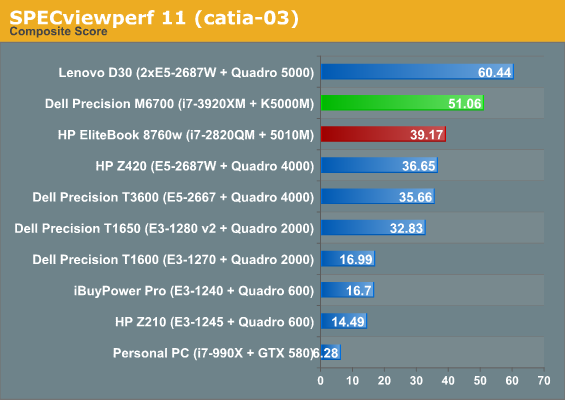
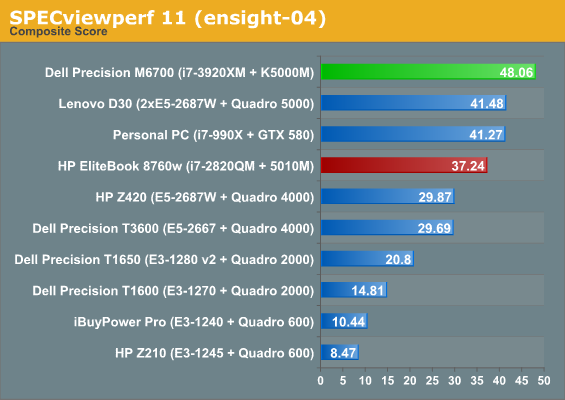
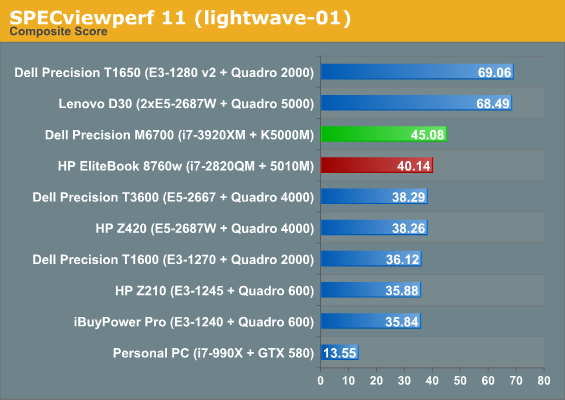
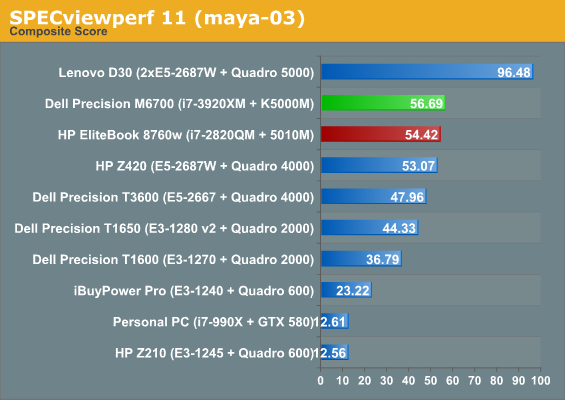
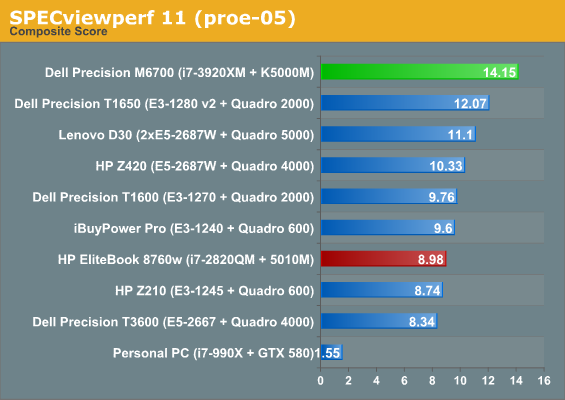
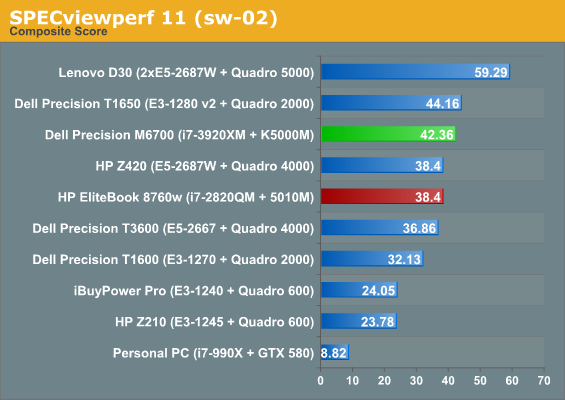
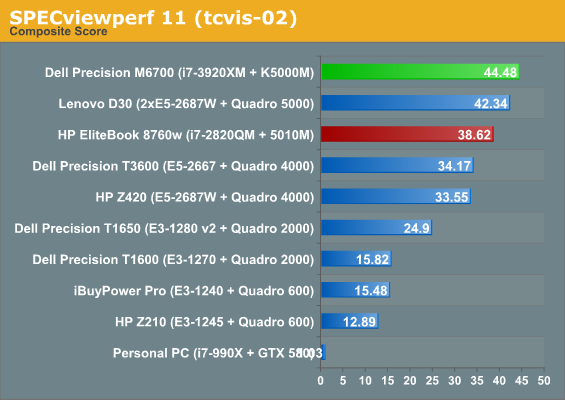
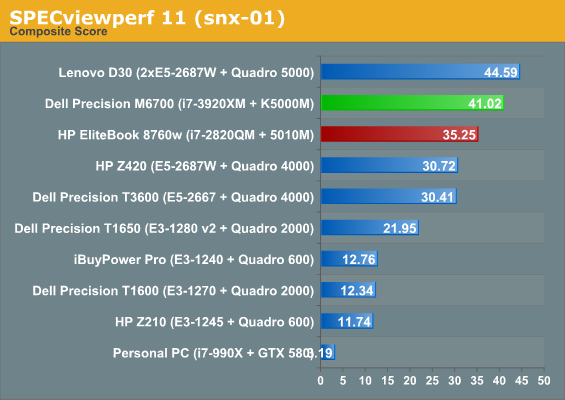
The sheer brute force of the Quadro K5000M, despite its substantially weakened FP64 performance, is enough to get it to score consistently better than the last generation GF100-based Quadro 5010M. Unless you need a high end desktop workstation GPU and a chip with more than four cores, Dell's Precision M6700 is capable of being a very potent workhorse. Remember that a Quadro 5000 desktop card costs almost $2,000 on its own; that puts the M6700's steep workstation price tag into a bit of perspective.
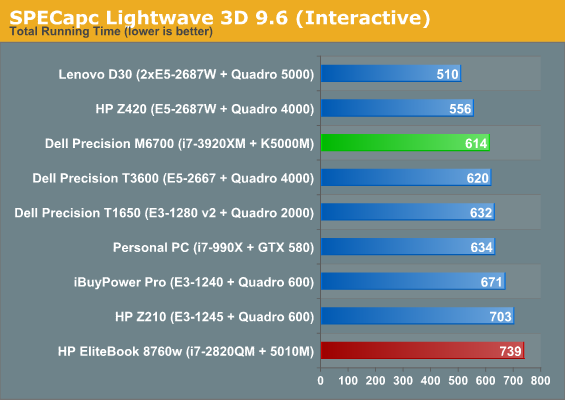
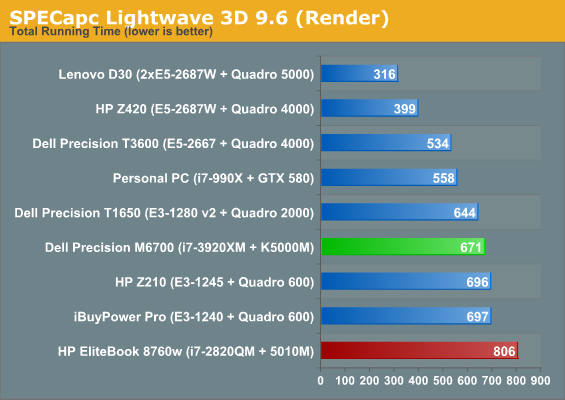

The M6700's CPU unfortunately gets hit harder in SPECapc Lightwave. Faster CPUs with higher core counts are the order of the day here, and though the i7-3920XM may be able to keep pace with a top-of-the-line Ivy Bridge CPU in short bursts, eventually its turbo speed settles down. Switching to a desktop workstation can still shave 33% off of Lightwave's render time, but you'll pay through the nose for it.










125 Comments
View All Comments
critical_ - Friday, December 14, 2012 - link
It may be technically possible but the issue is that I would much rather have more types of different ports than get stuck with a whole bunch of USB 3.0 ports. More USB 3.0 ports can be had through the port replicator, through an ExpressCard addon, or through a hub. In fact, there are still users of the M6700 that bemoan the loss of the PCMCIA slot in 2012. A fair bit of research goes into these workstation-class laptops to address the needs of large buyers. If Dell, HP, and Lenovo wanted to add a gazillion USB 3.0 ports then they would have done it but their target demographic doesn't want them.hrrmph - Friday, December 14, 2012 - link
"get stuck"?With more modern faster ports?
And I know that you haven't argued the point, but another user argued that Thunderbolt, an even faster port, was undesirable.
And, yes I'm sympathetic to the need to have backwards compatibility for a few years, especially for industrial equipment and applications.
But, 10 years is enough for a defunct standard.
IEEE 1394a? That died a decade ago.
Mobile workstations are the largest ships in their class. Are people arguing that these machines aren't physically capable of holding more ports?
My point isn't to say that any given legacy port shouldn't be included if it is popular and needed, but rather that at this lofty level of the market, you cannot expect people to comfortably transition away from the desktop if you don't give them something closer to desktop capabilities.
For Anand it took Thunderbolt combined with Pegasus storage to make the transition.
As a well-versed non-Apple PC user, I'm fairly confident in saying that the non-Apple manufacturers are very late to providing modern peripheral I/O ports.
I don't buy Apple, but I am jealous of their ability to buy machines with more peripheral bandwidth.
I would deploy that bandwidth very quickly... if I had it.
-
ShieTar - Friday, December 14, 2012 - link
What in the world does anybody do with multitudes of USB 3.0 ports anyways? Storage is generally connected through a network, and the USB ports on machines like this are usually only used for keyboard/mouse and software dongles.Seriously, I dare you to provide a single usage case, where the owner of such a notebook would even need the 2 USB3 ports.
hrrmph - Friday, December 14, 2012 - link
"Seriously, I dare you..."Ummm... okay... let's look around my desk...
128GB thumbdrives x 3;
64GB thumbdrive x 1;
External drives x 6;
Monitor with hub x 1.
All of them needing a USB 3.0 port to connect to... because... they are all-USB 3.0 by design.
----------------------
Oh...
My photo, slide, film scanner could use more bandwidth for transferring the results back to the host machine more quickly. So as soon as a faster operating, higher bandwidth version is available, I would like to replace that piece of equipment.
Even my printer takes too long to get rolling, so maybe more bandwidth is needed there.
-----------------------
Two thumbdrives are installed at all times and two external drives are installed at all times. That's 4 ports needed to start with.
A scanner and printer would be 2 more ports.
2 spare ports for transient devices (the occasional visiting thumbdrive, external drive, etc.) would be nice.
Hmm... thats 8.
----------------------
The USB 3.0 hub in the Dell 27" monitor can relieve some of that pressure, but not when I'm on the road using the display that is built in to the laptop.
As much as I prefer the Dell and would probably buy it over the HP mobile workstation (if I had to buy today), it must be admitted that HP has a better docking station solution for USB 3.0.
With the HP docking station's ports combined with the laptop's ports, you get USB 3.0 ports x 6 total. With Dell you get only 4.
Still, I wouldn't pay HP an additional $800 just for 2 extra USB 3.0 ports.
----------------------
I've tried adding an ExpressCard with USB 3.0 x 2 ports to my existing ancient HP 17" machine. It works.
I've even added USBGear Industrial Hubs x 2 with 4 additional ports on each hub. That gets me USB 3.0 ports x 8 on that old machine. It works (see my extensive reviews at Amazon for more info).
Although it works, its not ideal. Although it is much faster than USB 2.0, the limited bandwidth of the ExpressCard port takes about a a third or so of the performance off of the top of what it could be.
The ExpressCards themselves are bulky and stick out of the right front corner of my machine... occupying the same chunk of table real estate that my mouse would like to occupy.
The USBGear industrial hubs are great, but as with all other hubs that need to drive several external drives, external supplemental power is needed via a wall brick plugged into mains power.
If you use two hubs, then make that two extra wall bricks in addition to the massive wall brick needed to power a mobile workstation.
--------------------
All of this effort is just to try to bring my storage capabilities on the road up to something a little closer to what I have on my desktop machine at home.
I have 2.5inch x 15mm x 4 bay racks x 3 on my newest desktop machines for a total of 12 possible drives. There are usually 8 drives resident.
I could see the possibility of eventually migrating completely over to mobile workstations, but not unless the storage capabilities get better.
------------------
All in all, its just better for the manufacturers to build the USB 3.0 port into the machine.
A pair of Thunderbolt ports would nice too.
-
spiceshaper - Friday, December 14, 2012 - link
So why the f**k would you need to connect all that sh*t at the same time?hrrmph - Thursday, December 13, 2012 - link
Thunderbolt?Thunderbolt?
All I hear from Dell and HP are crickets.
-
p05esto - Thursday, December 13, 2012 - link
Really? Who uses Thunderbolt except Apple weinies who pay $50 for cables, lol. I own nothing that uses Thunderbolt. Fool.hrrmph - Thursday, December 13, 2012 - link
HP offers a docking station that lets you add 4 more USB 3.0 ports and a bunch of other ports.Dell has a USB 3.0 equipped docking station, but according to Dell's website the M6700 is unlisted as being compatible.
So Dell's most exclusive laptop isn't compatible with their most exclusive docking station?
I'm confused. How could this be? Or is it just that Dell's website is confused about what works with what?
-
critical_ - Thursday, December 13, 2012 - link
I have the correct docking station. It is Dell part # 331-7947 (or T0J21). It adds 2 more USB 3.0 ports.hrrmph - Thursday, December 13, 2012 - link
Again, thanks for the very helpful replies :)Especially regarding the part numbers for the docking stations and telephony cards. I've noted both part numbers in my 'lab' files.
If my 17" machine dies a terminal death, I will be replacing it with a Dell or HP mobile workstation. Right now Dell has the upper hand, partially because of price for what you get.
-